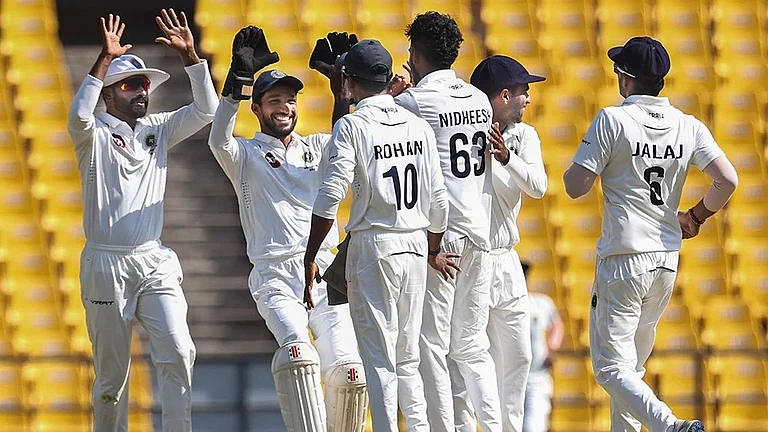But this does not mean that the PW had been completely marginalised. Such is the level of indoctrination among villagers, particularly the youth, that in Telangana hating the landlords and class enemies is virtually a religion for many. "I am happy about the attack but if it had been fully successful we would have been celebrating a real Dussehra," says Vaddepalli Srinu. An undergraduate student at a Warangal college, Srinu worked underground with the PW for three years till his arrest last June. He claims he will return to fight for the ‘revolution’. But not immediately, as he fears police retaliation on his family and because "most of the old networks have been destroyed".
The PW has recently suffered a string of reverses in its traditional northern Telangana stronghold, in the districts of Adilabad, Nizamabad, Karimnagar, Warangal and Khammam. Several leaders have been killed in ‘encounters’ and there has been a rash of high-profile surrenders. Telangana had once been dubbed a ‘liberated’ zone. But now liquor vends, which were too scared to operate before, are back in business.
There have been over 2,000 PW surrenders in the last four years, according to police records. This year, about 650 have come overground. "My wife requires a heart valve replacement surgery and our two children need looking after," says Vasari Surender of Akampatta village, who gave up four months ago after spending eight years fighting the class enemies. Personal compulsions and police pressure on families are the common reasons why the cadres are surrendering. Also, many feel the PW is still stuck in the ideology of the ’60s. The times have changed but the comrades haven’t and many of their methods seem impractical. Whatever the reasons, the PW’s 3,500-strong cadre a few years ago is now a mere 1,300.
"The PW’s greatest achievement has been the sense of security it has given ordinary citizens in Telangana. But it’s now suffering because of its failure to adapt to the changing times. Most landlords are gone, so the PW needs to be more creative and humane in its approach to remain relevant," says G. Haragopal, human rights professor, Hyderabad University.
The new targets of the group are politicians and the police. This year, 35 politicians have already been killed, 25 from the ruling TDP. Last year this figure was 23. In all, ever since its early active days, 10,000 people have died in Naxal violence in Andhra Pradesh. In other parts of the country the death toll has been over another 10,000.
Historically, Telangana has been the ideal breeding ground for extreme communist movements. Its oppressive feudal hierarchy dates back to the days of the Nizam when Telangana witnessed its first violent class struggle in 1946. However, that revolt died down. It was in the ’70s that the PW was formed by Kondapalli Seetharamaiah. It evolved a dream of a liberated Dandakaranya—the forest tracks of central-southern India covering AP, Orissa, Maharashtra and Bastar.
With the heat on in Andhra, Bastar is the unofficial headquarters of the PW now. Its Dantewada district epitomises the quiet but brutal internal war that rages in the heart of central India. Dantewada is hemmed in by the northern Telangana districts of Khammam and Warangal in the south, Gadchiroli and Chandranagar of Maharashtra in the west and Malkangiri district of Orissa in the east. MP is not too far either. It is what is called a ‘liberated’ zone.
Its liberation is of course not jurisdictional, but operational. While the government may officially claim to be in charge, in real terms it is the PW whose writ runs large and virtually unchallenged. The getaways are simple. When the Andhra Pradesh police launched a manhunt for the attackers of Naidu, the groups quickly melted away in Bastar. As inter-state police cooperation is not particularly smooth, escape is simple. If not Chhattisgarh, then there is Maharashtra or even Madhya Pradesh. Or the PW cadres can move to the border districts of Orissa where it is active.
The setting in Bastar provides the Naxalites the ideal cover—its lush green foliage, and its deep, virtually impenetrable forests. And national news doesn’t reach here. Take Dantewada. The number of villages regarded as ‘extra-sensitive’ by the authorities, in terms of PW presence, is 299; ‘sensitive’ villages are 96 while ‘normal’ villages are 200. As darkness descends, people prefer not to move outside. Shops down shutters. "You could be hit by a blast of AK-47 or a rocket launcher," says one police commandant. Adds Inspector General of Police S.K. Paswan: "People who do not agree with their ideology are in trouble."
In this tribal area, where the economic paradigms scarcely match the rattle of high calibre arms and ammunitions, danger lurks just beneath the surface. A potent exhibition of this came on April 13 this year when a group of Naxal guerrillas entered the Gidam police station in the township, snatched arms and killed two policemen. A signed PW statement released to the press boasted of the attack.
There are areas in Bastar which have never been visited by an outsider. "It is true. The Abhuj Marh area, a 4,000 square kilometre plateau, has never been surveyed by anyone, including the British," Chhattisgarh chief minister Ajit Jogi told Outlook, "No one knows what goes on there." With no access for anyone—including the government—the PW is virtually in charge of the desolate plateau.
The PW in Bihar and Jharkhand has established links with the Maoists of Nepal. According to SP Binay Kumar Singh of the Special Task Force, there are strong indications that the PW has been procuring arms with the help of Nepalese outfits. There is also talk of the PW strengthening its grip in the ‘Red Corridor’ which extends through Nepal, Bihar, Madhya Pradesh, Chhattisgarh and Andhra Pradesh. There is Naxal presence in 28 districts of Bihar, with the PW very active in eight of them. In neighbouring Jharkhand, the situation is no better. It was only last September that the then chief minister Babu Lal Marandi’s vehicle was attacked. The PW is known to be active in 37 districts in the state.
While the PW has been banned in all other states, it is still overground in West Bengal. The group is active in the North and South 24 Parganas districts. Some CPI(M) cadres have been targeted but largely the activists work with the peasantry and are more interested in widening their base than fighting the establishment.
Maharashtra is perhaps where the outfit is fast running out of support. Over the last year, as many as 120 villages in Gadchiroli have refused to entertain activists of the group. It is clear that the PW’s influence is shrinking, although in their small pockets of influence, it is still strong. Just last week, a police constable was kidnapped in Gadchiroli, the group demanding the withdrawal of police cases against activists. There is now talk of the PW shifting base to its former strongholds in the state like Jalgaon and Nashik.
But the key to how active the PW will be in the future depends on its base in Andhra Pradesh. It is leaders from Telangana who guide the activities of the ‘dalams’, or units, in other states. The Andhra police is aware that though it has managed to eliminate some key operatives, the top leadership remains intact. Says a senior officer, "Their strength lies in the fact that they are willing to fight a protracted war, time is not their concern. They will retreat and advance as the situation demands." For now, the PW is in retreat mode.
By Savitri Choudhury in Telangana and Ranjit Bhushan in Bastar with Subodh Mishra in Patna, Priyanka Kakodkar in Mumbai and Ashis K. Biswas in Calcutta






















